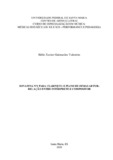| dc.contributor.advisor | Garbosa, Guilherme Sampaio | |
| dc.creator | Valentim, Hélio Xavier Guimarães | |
| dc.date.accessioned | 2021-06-25T16:09:18Z | |
| dc.date.available | 2021-06-25T16:09:18Z | |
| dc.date.issued | 2020-10-01 | |
| dc.date.submitted | 2020 | |
| dc.identifier.uri | http://repositorio.ufsm.br/handle/1/21238 | |
| dc.description | Monografia (especialização) - Universidade Federal de Santa Maria, Centro de Artes e Letras, Curso de Especialização em Música: Músicas dos Séculos XX e XXI - Performance e Pedagogia, RS, 2020. | por |
| dc.description.abstract | Interpreter-composer relationships have arisen throughout the history of the clarinet, such as
Wolfgang Mozart and Anton Stadler, Karl Stamitz and Joseph Beer, Johannes Brahms and
Richard Muhlfeld, Carl Maria von Weber and Heinrich Baermann, Louis Spohr and Simon
Hermstedt, Aaron Copland and Benny Goodman, among others. (GARBOSA, 2002). Countless
pieces for the instrument have been composed from these relationships. This study aimed to
verify the implications of the relationship between interpreter and composer in the composition
Sonatina nº 1 for clarinet and piano by Dimas Artur. The objectives were to collaborate on the
structuring of the piece, demonstrate the idiomatic aspects of the instrument and elucidate its
technique. Authors such as LÔBO (2016), PINTO (2006), BRANDINO (2012), LAWSON
(1995), RICE (2017), WESTON (2002) and FOSS (1963) grounded the study and a qualitative
research method was developed using the Research–Action approach (FONSECA, 2002),
which consisted of five meetings between the interpreter and the composer. In these meetings
the structure of the composition and the use of clarinet technical resources were discussed and
agreed upon. This interaction between interpreter and composer resulted in Sonatina nº 1 which
has the following characteristics: three movements (Allegretto Scherzando, Adagio and
Scherzando), extended techniques (frullato, glissando, multiphonics and bend), musical form
(ternary, binary and unitary), idiomatic characteristics and Brazilian rhythmic elements. | eng |
| dc.language | por | por |
| dc.publisher | Universidade Federal de Santa Maria | por |
| dc.rights | Acesso Aberto | por |
| dc.rights | Attribution-NonCommercial-NoDerivatives 4.0 International | * |
| dc.rights.uri | http://creativecommons.org/licenses/by-nc-nd/4.0/ | * |
| dc.subject | Intérprete | por |
| dc.subject | Compositor | por |
| dc.subject | Sonatina | por |
| dc.subject | Clarineta | por |
| dc.subject | Dimas Artur | por |
| dc.title | Sonatina nº1 para clarineta e piano de Dimas Artur: relação entre intérprete e compositor | por |
| dc.title.alternative | Sonatina nº1 for clarinet and piano by Dimas Artur: relationship between interpreter and composer | eng |
| dc.type | Trabalho de Conclusão de Curso de Especialização | por |
| dc.degree.local | 97 p. | por |
| dc.degree.specialization | Música: Músicas dos Séculos XX e XXI - Performance e Pedagogia | por |
| dc.description.resumo | A relação intérprete-compositor pode ser observada ao longo da história da clarineta, como com
Wolfgang Mozart e Anton Stadler, Karl Stamitz e Joseph Beer, Johannes Brahms e Richard
Muhlfeld, Carl Maria von Weber e Heinrich Baermann, Louis Spohr e Simon Hermstedt, Aaron
Copland e Benny Goodman, entre outros. (GARBOSA, 2002). Dessas relações, inúmeras obras
foram compostas para o instrumento. Nesse sentido, este estudo objetivou verificar as
implicações na relação entre intérprete e compositor na composição da Sonatina nº 1 para
clarineta e piano de Dimas Artur. Os objetivos foram, especificamente, colaborar com a
estruturação da peça, demonstrar os aspectos idiomáticos do instrumento e esclarecer sobre a
técnica do instrumento. Autores como LÔBO (2016), PINTO (2006), BRANDINO (2012),
LAWSON (1995), RICE (2017), WESTON (2002) e FOSS (1963) fundamentaram esta
pesquisa. A pesquisa de abordagem qualitativa desenvolveu-se por meio da Pesquisa–Ação
(FONSECA, 2002) feita em cinco encontros entre o intérprete e o compositor. Nesses
encontros, foram discutidos e acordados a estrutura da obra e a utilização dos recursos técnicos
da clarineta. Dessa interação entre intérprete e compositor resultou na Sonatina nº 1 que tem as
seguintes características: três movimentos (Allegretto Scherzando, Adagio e Scherzando),
técnicas estendidas (frulato, glissando, multifônicos e bend), forma musical (ternária, binaria e
unitária), características idiomáticas e elementos rítmicos brasileiros. | por |
| dc.publisher.country | Brasil | por |
| dc.publisher.initials | UFSM | por |
| dc.subject.cnpq | CNPQ::LINGUISTICA, LETRAS E ARTES::ARTES::MUSICA | por |
| dc.publisher.unidade | Centro de Artes e Letras | por |



